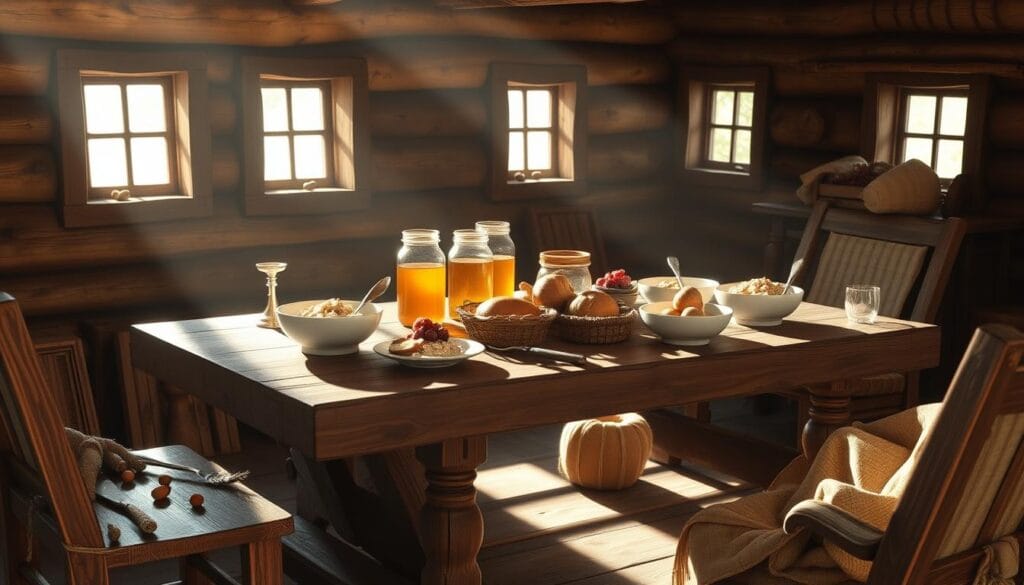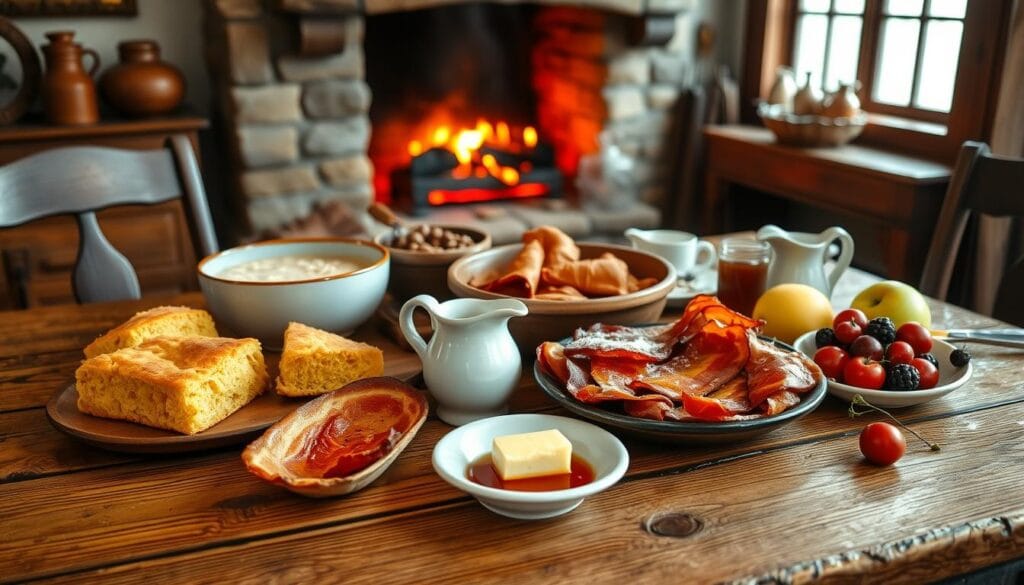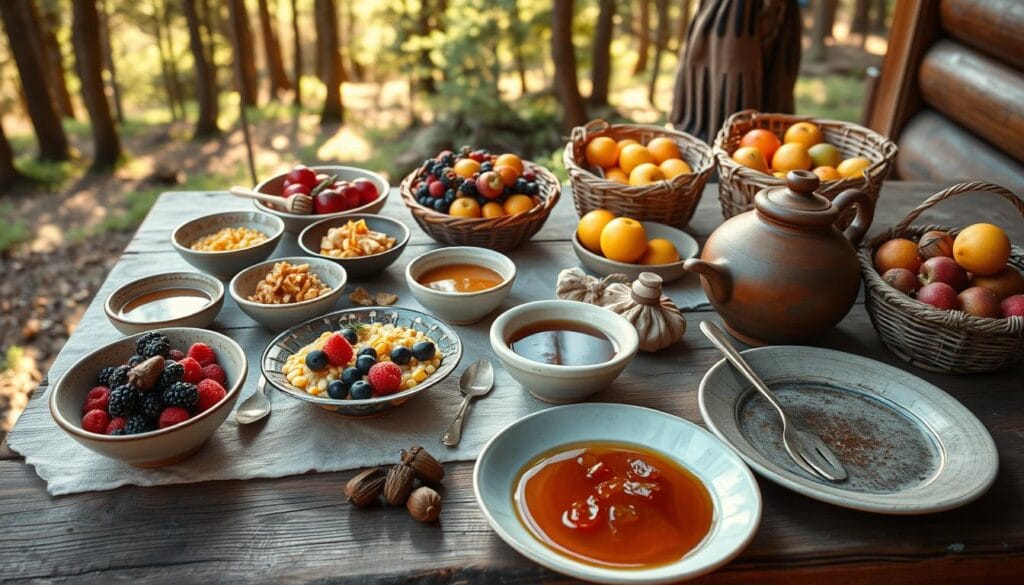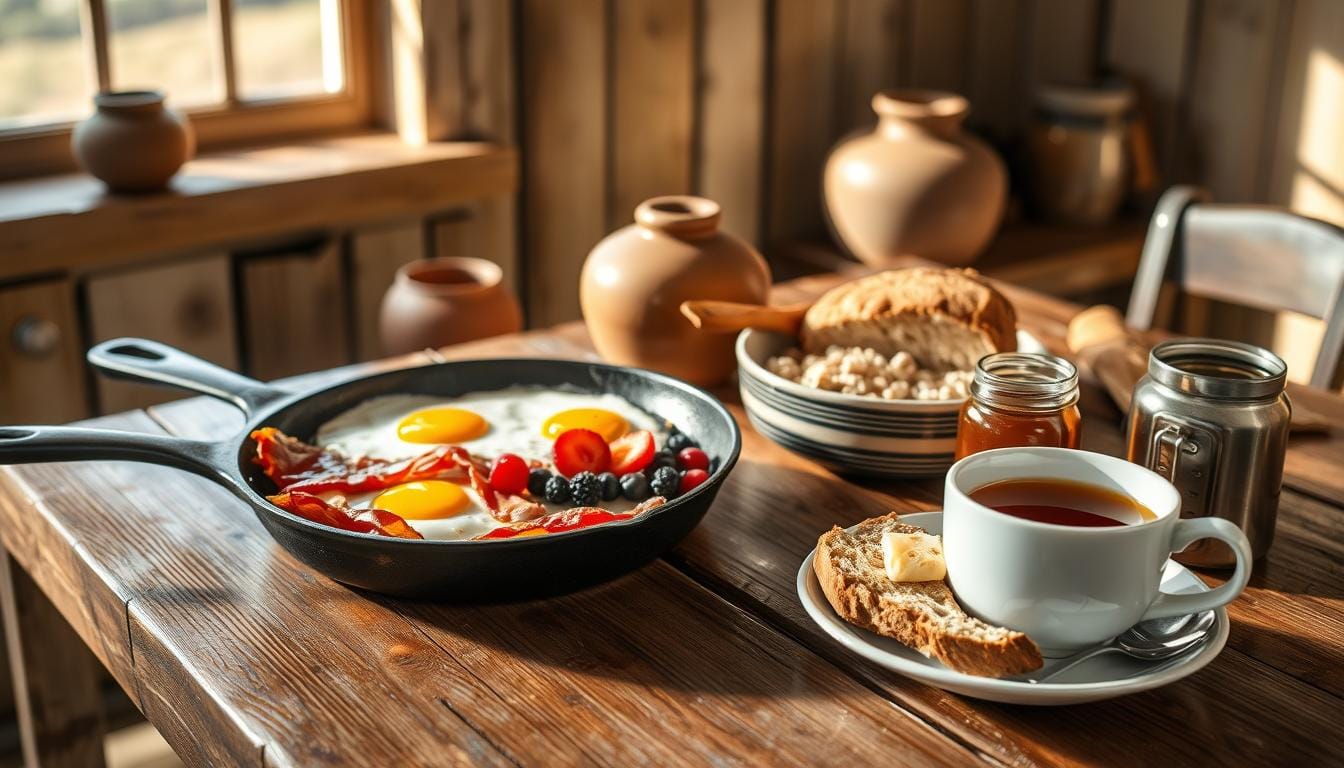Have you ever wondered, “What did early settlers eat for breakfast?” Breakfast was a big deal in their daily lives. It was shaped by their European roots and what was available in the New World.
They usually had a filling meal with porridge, bread, and other staples. These foods were common for early settlers.
Colonial families had different breakfasts based on where they lived and the season. In the Northeast, baked beans were a favorite. But in other places, cornbread and grits were more common.
Exploring the history of breakfast in America is fascinating. It shows how breakfast shaped the lives of early settlers.
The Morning Ritual: What Did Early Settlers Eat for Breakfast?
Exploring colonial households’ daily lives suggests how important their morning ritual changed into. In colonial America, households woke up early, before the solar rose. This morning ritual set the day’s tone.

Colonial households followed a strict day by day agenda. Breakfast changed into a key meal, with meals picks primarily based on place and season.
Daily Schedule of Colonial Families
A typical day started with a hearty breakfast. Then, families had a busy day of chores and activities. The morning ritual helped them get ready for the day.
Kitchen Tools and Cooking Methods
Colonial families used simple tools like fireplaces and cast-iron pots for cooking. The morning ritual was a time for families to share meals. Traditional dishes like porridge were common.
The Role of Breakfast in Settler Life
Breakfast was essential for colonial settlers, giving them energy for the day. The morning ritual helped families bond and prepare. In colonial America, breakfast was a big part of daily life, showing community values.
Common Breakfast Foods: What Did Early Settlers Eat for Breakfast?
Exploring colonial America’s breakfast foods reveals their importance in settlers’ lives. Ingredients and European traditions influenced these dishes. Porridge, bread, and cornmeal mush were staples, giving settlers the energy to begin their day.
Breakfasts varied by region and social class in colonial America. Porridge was a favorite, made from oats, cornmeal, or wheat. It was often topped with milk, butter, or eggs. Bread was a must, baked in ovens or over fires. Cornmeal mush was popular in the south, where corn was plentiful.
Some common breakfast foods in colonial America included:
- Porridge with milk and butter
- Bread with cheese or eggs
- Cornmeal mush with honey or maple syrup

These dishes were not just delicious. They also showed the impact of European cuisine. Learning about colonial America’s breakfast foods helps us understand the country’s culinary roots.
Native American Influences: What Did Early Settlers Eat for Breakfast?
As settlers met Native Americans, they picked up new breakfast habits. They started making meals with corn, thanks to cultural exchange. This led to settlers adding Native American breakfasts to their own.
Native American breakfasts included cornmeal mush, wild fruits, and nuts. They made these foods by grinding corn or roasting nuts over a fire.
This mix of cultures created a new breakfast style. Settlers used Native American ingredients and ways to cook. For instance:
- Corn-based dishes like pancakes or cornbread
- Wild fruit preserves, like blueberry or cranberry
- Roasted nuts in oatmeal or yogurt

The meeting of Native Americans and settlers changed breakfasts for settlers. Many Native American foods became common in settler meals.
| Native American Breakfast Food | Settler Adaptation |
|---|---|
| Cornmeal mush | Cornmeal pancakes or cornbread |
| Wild fruits | Wild fruit preserves or jams |
| Roasted nuts | Added to oatmeal or yogurt |
What Did Early Settlers Eat for Breakfast in Different Regions?
Exploring American cuisine history answers the question, “What did early settlers eat for breakfast?” Breakfast habits varied greatly by region, influenced by ingredients, climate, and cultural traditions. Each area developed its own unique breakfast customs.
In the Northeast, baked beans were a staple, while the South favored cornbread and grits. These choices reflect the resourcefulness of early settlers in adapting to their surroundings.
Some regional breakfast specialties included:
- New England: baked beans, maple syrup, and apple cider
- Southern colonies: cornbread, grits, and peaches
- Other regions: unique combinations of local ingredients, including wild game and foraged fruits
These variations highlight the diversity and creativity of American cuisine. By exploring these differences, you can better understand the country’s culinary history.
As you learn more about American breakfast traditions, you’ll discover how culture and environment shaped regional dishes. From the resourcefulness of early settlers to today’s breakfasts, the story of American cuisine is rich and fascinating.
| Region | Breakfast Specialty |
|---|---|
| New England | baked beans, maple syrup, and apple cider |
| Southern colonies | cornbread, grits, and peaches |
| Other regions | unique combinations of local ingredients |
Seasonal Shifts in Breakfast Choices: What Did Early Settlers Eat for Breakfast?
As the seasons changed, so did the colonial breakfast choices. In winter, salted meats and dried fruits were not unusual. Summer added fresh meals like culmination and veggies.
In the colonial generation, maintaining food changed into key. Techniques like smoking, salting, and pickling were used. This way, colonists may want to experience a number of ingredients even in winter.
Some common colonial breakfast meals that numerous with the seasons include:
- Winter: salted meats, dried end result, and preserved vegetables
- Summer: clean fruits, vegetables, and corn-based dishes
- Harvest time: hearty food made with freshly harvested ingredients
Understanding the seasonal changes in colonial breakfast selections offers us insight. The colonists have been inventive and adaptable. They preserved food and altered their diets with the seasons, thriving in a new surroundings.
Season Common Breakfast FoodsWinterSalted meats, dried fruits, preserved vegetablesSummerFresh end result, greens, corn-primarily based dishesHarvest timeHearty food made with freshly harvested elementseserved food and adjusted their diets with the seasons, thriving in a new environment.
| Season | Common Breakfast Foods |
|---|---|
| Winter | Salted meats, dried fruits, preserved vegetables |
| Summer | Fresh fruits, vegetables, corn-based dishes |
| Harvest time | Hearty meals made with freshly harvested ingredients |
Bread and Grain-Based Morning Foods
In colonial America, bread and grain-based foods were key. They gave settlers the energy to start their day. Foods like cornbread, biscuits, were made with simple ingredients like cornmeal, flour, and water.
They were often served with butter, jam, and honey. This made them taste better and more nutritious.
A typical morning meal might include bread with cheese, eggs, or beef sousage. Grain-based foods like oatmeal or porridge were also favorites. These foods were tasty and gave settlers the energy they needed for the day.
- Cornbread
- Biscuits
- Oatmeal
- Porridge
These foods were often made more delicious with butter, jam, and honey.
| Food | Ingredients | Preparation |
|---|---|---|
| Cornbread | Cornmeal, flour, water | Baked in a skillet |
| Biscuits | Flour, water, butter | Baked in a oven |
In conclusion, bread and grain-based foods were vital in colonial America. They gave settlers the energy and nutrition they needed for the day. These foods were often enhanced with other ingredients to make them more tasty and nutrition.
The Role of Dairy Products in Colonial Breakfasts
Dairy products were key in colonial breakfasts, giving people the nutrition they needed to start their day. It’s interesting to note that dairy was a common item in many homes. Butter and cheese were used in various dishes.
Butter making was a big deal in colonial America. Families churned their own butter from cow, goat, and sheep milk. This butter was used for spreading and cooking, adding flavor and moisture to breakfast foods. Cheese was also a favorite, with many making their own from animal milk.
Butter Making and Usage
Butter making was hard work, involving churning cream until it turned into butter and buttermilk. The butter was then shaped and used in foods like pancakes and waffles. Imagine the smell of freshly baked bread with melted butter, a treat in colonial America.
Cheese in Morning Meals
Cheese was used in many breakfast dishes, like omelets and pancakes. It was also enjoyed on its own with bread or crackers. Cheese added protein, calcium, and other nutrients to breakfasts.
Adding dairy to your breakfast can improve your well-being. Whether it’s butter, cheese, or other dairy, there are many ways to include it in a balanced meal.
Learning about dairy in colonial breakfasts shows its importance in early American diets. So, when you have butter or cheese in your breakfast, think about the history and culture behind it.
Early American Breakfast Beverages
Exploring the history of breakfast in colonial America shows us how important drinks were. Coffee, tea, milk, and water were the main drinks. They gave settlers the energy they needed to begin their day.
Coffee and tea came from Europe, while milk and water were local. Coffee became popular in the U.S. in the 1770s after the Boston Tea Party. This was because people boycotted tea to protest British taxes. By the 1830s, coffee was so common that pioneers took coffee beans with them on their westward journeys.
By the mid-1700s, Americans drank about 35 gallons of hard cider each year. Even famous people like John Adams drank cider for breakfast.
Here are some key statistics about early American breakfast beverages:
- Coffee became popular in the U.S. in the 1770s
- By the 1830s, coffee was commonplace enough for pioneers to carry coffee beans on their journeys westward
- Hard cider was a popular breakfast beverage, with the average American drinking 35 gallons per year by the mid-1700s
| Breakfast Beverage | Popularity | Source |
|---|---|---|
| Coffee | High | Imported from Europe |
| Tea | High | Imported from Europe |
| Hard Cider | High | Local sources |
These drinks were key to the daily lives of colonists. They provided the energy needed for the day. Whether it was coffee, tea, or hard cider, these drinks shaped the breakfast habits of early Americans.
Food Storage and Preservation Methods
In colonial America, keeping food fresh was key. People had to get creative to store food, mainly because fresh food was hard to find in winter. Root cellars were a big help. These underground rooms kept food cool and fresh for longer.
Drying food was another important method. It removed moisture to stop food from spoiling. This way, you could enjoy dried meats, fruits, and veggies all year. Boiling and simmering were also used to keep food fresh longer. These methods were vital for survival in colonial times.
Effective Preservation Techniques
Some effective preservation techniques used in colonial America included:
- Drying and smoking meats to preserve them for long periods
- Using root cellars to store fruits and vegetables
- Boiling and simmering foods to kill bacteria and extend shelf life
These methods let people enjoy different foods throughout the year. Even when fresh food was hard to find, they kept food fresh and nutritious, which was important for staying strong in colonial America
Conclusion
The breakfast habits of early American settlers had been captivating. They blended European traditions, local ingredients, and Native American influences. This mix created hearty meals like porridge, bread, and corn-based dishes.
These food gave settlers the power they wished. They faced many demanding situations in building a brand new lifestyles. Breakfast became key to their achievement.
Breakfast developed over time, showing the settlers’ adaptability. They used local foods and mixed cooking patterns. This created a unique American breakfast way of life.
Learning about our ancestors’ breakfasts allows us admire American cuisine. It indicates how numerous our meals culture is. It also reminds us of the significance of beginning our day with an amazing meal.
FAQ
Q: What did early settlers eat for breakfast?
A: Early American settlers’ breakfasts were influenced by their European roots and the New World’s ingredients. They enjoyed a hearty meal of porridge, bread, and other staples. The breakfast varied by region and season.
Q: What was the morning ritual like in early American settlements?
A: Morning rituals in early America were key to daily life. Families began their day early, with breakfast being a main meal. Breakfasts included porridge, bread, and other staples, depending on the season and region.
Kitchen tools and cooking methods were simple. Many families used fireplaces and cast-iron pots for cooking.
Q: What were the common breakfast foods in colonial America?
A: Colonial breakfasts were shaped by available ingredients and European heritage. Porridge, bread, and cornmeal mush were common. They were often served with milk, butter, and eggs.
These foods were tasty and gave settlers the energy to start their day.
Q: How did Native American influences shape settler breakfast habits?
A: Native American influences were big on settler breakfasts. Many settlers adopted corn-based meals and Native American cooking ways. This mix created a unique and tasty breakfast cuisine.
Q: What were the regional variations in early settler breakfast habits?
A: Breakfast habits varied by region, influenced by ingredients, climate, and culture. The Northeast, South, and other areas had their own breakfast traditions. For example, baked beans were popular in the Northeast, while cornbread and grits were favorites in the South.
Q: How did seasonal changes affect colonial breakfast choices?
A: Seasonal changes greatly affected breakfast choices. In winter, preserved foods like salted meats and dried fruits were common. Summer brought fresh fruits and vegetables.
Harvest time was special, with families enjoying meals made from fresh ingredients.
Q: What was the importance of bread and grain-based morning foods in colonial America?
A: Bread and grain-based foods were vital in colonial America. They were tasty and gave settlers the energy to start their day. Cornbread, biscuits, and other staples were made with simple ingredients like cornmeal, flour, and water.
They were often served with butter, jam, and honey.
Q: What was the role of dairy products in colonial breakfasts?
A: Dairy products played a big role in colonial breakfasts. Butter and cheese were staples. Butter was made from cow, goat, and sheep milk, used for spreading and cooking.
Cheese was also important, with many families making their own from animal milk.
Q: What were the early American breakfast beverages?
A: Early American breakfast drinks were simple. Families enjoyed coffee, tea, milk, and water. These drinks were delicious and gave settlers the energy to start their day.
Coffee and tea came from Europe, while milk and water were local.
Q: How did early settlers store and preserve their food?
A: Food storage and preservation were key for settlers. Root cellars stored fruits, vegetables, and other foods. Drying and preserving techniques kept meats, fruits, and vegetables fresh.
These methods allowed settlers to enjoy a variety of foods all year, even in winter when fresh foods were scarce.

